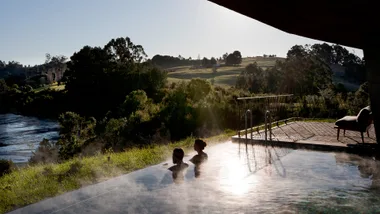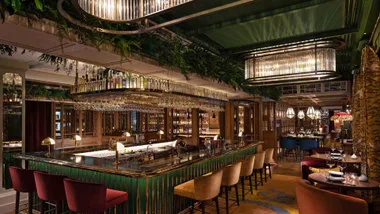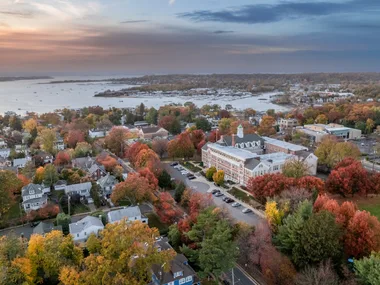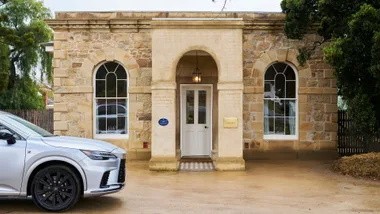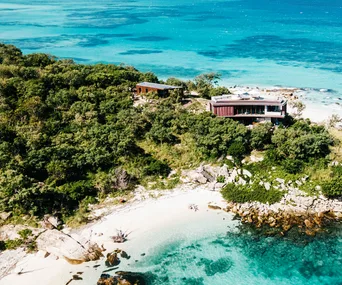GETTING THERE
Ponza is reached by hydrofoil or ferry from the ports of Formia, Anzio and Terracina, all an hour or so by car or by train from Rome and Naples. By hydrofoil the crossing takes an hour and 10 minutes, by ferry about two and a half hours. Book tickets online (Vetor Aliscafi, vetor.it; Laziomar, laziomar.it) or at quayside kiosks. Non-residents aren’t allowed to drive their own cars on the island in summer, but cars may be hired. Most travellers, though, use small buses or taxis, or hire scooters and boats. ponzaviaggi.it
The port is the only town on Ponza, but it takes no more than 20 minutes to walk through it from end to end, from the harbour to a series of pleasant sandy beaches. Much of the rest of the coastline of the island – eight kilometres long, a little over two kilometres across at its widest point – is sheer cliff interspersed with splendid coves and grottoes. Ponza is known as the isola lunata, or “moonlike island”, on account of its rescent shape. Jacques Cousteau apparently described it as the most beautiful in the Mediterranean.
I’ve sailed by hydrofoil from Anzio, famous for the World War II battle, 50 kilometres south-west of Rome. There are just four other passengers – two American students and a middle-aged German couple. More people are leaving Ponza than arriving on this late June day. Last night was the climax of a week’s feasting in honour of the patron saint, San Silverio, when a statue garlanded with coral was paraded through the streets. It’s the most important event on the island calendar, a festival of music, fireworks and processions that draws the descendants of Ponzesi emigrants from all over the world, swelling the population from 3,500 to 15,000. But as I disembark, the carnival is over and strapping youths are lugging away decorations and putting floats into storage.

Grotte di Pilato, Ponza
Ponza is the largest of the Pontine Islands off the coast of Italy’s Lazio region; the others are Ventotene, Palmarola, Zannone, Gavi and Santo Stefano. There are, as far as I know, no specific travel guides about the archipelago and surprisingly little literature. In northern Italy, where I live, it’s one of those destinations that everyone talks about but hardly anyone has been to. Yet the islands have an aura at once of exclusivity and obscurity, that make them a favourite hideaway for the rich and famous. The Fendi sisters have a villa on Palmarola, and the locals tell me that Naomi Campbell, Monica Bellucci, Michael Douglas and Giorgio Armani have holidayed on Ponza. So maybe it’s not a coincidence that the first person I bump into is film director Paolo Sorrentino, whose The Great Beauty won the Academy Award for Best Foreign Language Film in 2014. I like to think he was looking for locations for a new project. He wouldn’t be the first director to shoot a film on Ponza, after all. In the 1950s the island’s rugged scenery and spiky vegetation featured in many a Cinecittà sword-and-sandal epic, and in the 1960s it was the setting for Fellini’s Satyricon and an Italian TV adaptation of The Count of Monte Cristo.
Sorrentino is staying at the swish and sprawling Grand Hotel Santa Domitilla on a hill off the promenade.I’d gone there for aperitivi with another guest, Matthew Fort, a British writer and broadcaster who was hopping round Italy’s minor islands with the purpose of writing a book about them. Fort had arrived by hydrofoil from Formia after a week’s research on Procida, Ischia and Capri. The company of an old and insightful friend makes the stay on Ponza all the more enjoyable.
I’m staying at the delightful little Hotel Mari on the promenade, where the friendly owners Luigi and Angela Tagliamonte offer a wealth of advice on what to do and where to go. My room has a wonderful view over the bay, its balcony a perfect vantage point, like the prow of a ship.
If I walk a couple of blocks uphill behind the hotel, I’m on the other side of the island. In the backstreets – some cobbled, others dusty and unpaved – women sit at their front doors, podding peas and chatting. Caper flowers peek from cracks in the walls, and between some of the houses there are gaping holes in the black volcanic rock, negotiable by walkways and steps.

The flat-topped houses of Ponza Porto.
Ponza has been identified as the island of Aeaea – from Eos, the Greek goddess of the dawn – where the enchantress Circe tried to cast a spell on the hero Odysseus in Homer’s epic The Odyssey. After less than a day it’s Ponza that’s casting a spell on me.
Come to think of it, confinement is a leitmotif of Ponza’s history. In Roman times the emperor Tiberius exiled Caligula’s brothers, sister and wife on the island,and San Silverio suffered the same fate in 537. In the 17th century the Bourbons installed their notorious prisons here; a pretty guesthouse, Terrazza sul Porto, is housed in one of them – tastefully restored, of course. In 1857, the Italian patriot Carlo Pisacane freed 300 prisoners serving life sentences on the island in an abortive attempt to stir up an anti-Bourbon revolt. Pity he got the wrong jail. The convicts on Ponza were common criminals, the political prisoners were locked away on Ventotene.
In 1928, the Fascist regime began sending political opponents into exile on Ponza. One of these so-called confinati was the socialist Sandro Pertini, later to become president of Italy from 1978 to 1985. When Fascism fell in 1943, the tables were turned and Mussolini himself was imprisoned on the island for 10 days. It’s said that Ponza was so isolated that when Mussolini turned up, many of the islanders had no idea who he was. An article in the New York Times in January 1944 reports an American officer as saying “It was like stepping into another world…”
In many ways, it still is. Beyond July and August, Ponza is relatively free of mass tourism. It also seems innocent of commercialisation: no supermarkets, just proper old-fashioned grocery stores; no surfeit of trashy souvenir bazaars but, rather, little shops selling the practical accoutrements of swimming, scuba diving and sailing. All you need, really, for a holiday on the island.

Quiet streets of Ponza Porto
Administratively, Ponza depends on the Lazio region surrounding Rome, but culturally it owes more to the Campania region, home to Naples. For centuries the Pontine Islands were subject to raids by Muslim pirates from Turkey and North Africa. In the 1730s, it was the Bourbons in Naples who sent 28 families from Ischia in the Bay of Naples to colonise them. More followed later, along with 27 families from Torre del Greco, just south of Naples, survivors of an eruption of Vesuvius in 1772. No wonder the dialect you hear in the streets of Ponza is so close to Neapolitan.
The Neapolitan influence is also evident in Ponza’s street food. One day Fort and I settle outside one of the many friggitorie, fried-food shops, for a lunch of bean and onion soup, polpette di merluzzo (cod fritters), polpette di alghe (algae fritters), fried eggplant and zucchini flowers, and mozzarella in carrozza (small fried mozzarella sandwiches). We might as well be in Naples. The proprietor, a jolly elderly woman, emerges bearing a gift: a plate of flat, crisp focaccia she calls lingue di suocera, mother-in-law’s tongues. What would we like to drink, she asks – milk? Us, milk? She returns with a makeshift wine list and we make do with an Aglianico from Campania.
Otherwise – wine-wise, that is – we stick to the local Biancolella and Fieno di Ponza whites. They’re something of a discovery, both made from the biancolella grape brought by the Ischitani colonisers in the 18th century and grown on a plateau below the Faro della Guardia, a spectacular 19th-century lighthouse on the southern tip of the island. It becomes a habit of an evening to stop off for a glass of one or other at the charming little Enoteca l’Isola del Vino on the quayside, run by the equally charming Simone Addessi.

A shopping strip in Ponza.
The windows of Ponza’s cafés and pâtisseries display cakes and confectionery – babà, small mushroom-shaped sponge cakes soaked in a syrup of sugar and rum; pastiere, shortcrust pastry tarts; sfogliatelle, light, crisp snail-shaped pastries – all unmistakably of Neapolitan lineage. Fort, who has a sweet tooth, stops off every morning for breakfast at Pasticceria Napoletana on the promenade: espresso and aragosta, or lobster, a sort of sfogliatella filled with crème pâtissière and whipped cream. “Crunchy, squidgy, monstrously indulgent,” is how he describes it. De gustibus non est disputandum.
Moving up the dining scale, for a small island Ponza has a remarkable number of fine restaurants, all with tables on panoramic terraces that are worth the bill on their own. It would be misleading to speak of a specific cucina Ponzese; more than any local tradition, dishes reflect the expertise of individual chefs. The sign on the door of Eea, on the hill overlooking the port, says it all: “Cucina Mediterranea”. The restaurant is run by chef Davide De Luca, Ponza born and bred. It’s he who tells us the full story of San Silverio. He was Pope for a year in 536, then accused of conspiring with the Goths and exiled from Rome. He ended up on Ponza and attracted a local following. According to legend, he was venerated as a saint after a miracle in which he appeared to fishermen caught in a storm off Palmarola and steered them to safety. Silverio is the most common name on the island, incidentally.
The restaurant was established in 1951 by De Luca’s grandfather, Temistocle. In the 1930s, its imposing rooms had been used as dormitories for the confinati. Sandro Pertini and Temistocle used to play the violin together here, he says.
The emphasis at all the restaurants is unerringly on seafood. Livestock is conspicuous by its absence on the island, and under “Carni”, menus always feature a token filetto. At Eea there’s coniglio alla Ponzese, rabbit Ponza-style with tomatoes and chilli. De Luca says rabbits are a specialty of Le Forna, a cluster of houses in the north-east hills of the island. But diners invariably demand fish, so he and his family often end up eating the rabbit dish themselves.
At Eea I order cod coated with ground pistachio and served with potatoes and a torretta di melanzane, a little tower of eggplant, Silano cheese and tomato, like an individual Parmigiana. It’s a good example of De Luca’s knack of combining homegrown ingredients with others brought from the mainland – in this case, cheese from Calabria. Another highlight is ziti with sweet green peppers and Provolone del Monaco, a cheese from the Sorrentine peninsula.

The Grand Hotel Santa Domitilla
Another great place to dine is the one-star Acqua Pazza on Piazza Carlo Pisacane (the same names recur on the island). It’s run by the husband-and-wife team of appropriately named Gino Pesce (“pesce” means fish in Italian) and Patrizia Ronca. My octopus and potato is pepped up with a purée of green beans in which I detect a dash of vinegar, followed by steamed squid stuffed with creamed salt cod, reminscent of a Provençale brandade. Both are original takes on typical Mediterranean themes, brilliantly executed by Ronca in the kitchen. It’s early in the season but the restaurant is already packed inside and out.
Back at Hotel Mari, I’m enjoying the cool night air on the balcony when I see a curious scene unfold. Down in the black water of the harbour, a rubber dinghy appears in a ray of moonlight. It’s steered by a young man accompanied by four women dressed to party. At the quay the girls leap out and, performing impressive feats of dexterity, rope the dinghy to a bollard. Then they saunter into the darkness, laughing and joking. It’s all done with the utmost naturalness. It strikes me that the bay is the Ponzesi’s backyard, that their lives revolve around the sea.
The Tagliamontes at the Mari tell me the best way to see the island is from the sea, so one day we sign up for a periplus in a converted fishing boat. Unaccountably, I’m named capogruppo, or group leader. Unsure what my title entails (nothing, really, as it turns out), I set about fraternising with our fellow daytrippers. There are eight of them, all young Italians. The liveliest is Mariana, who opens up as only Neapolitans can. She has been coming to Ponza for her summer holidays since she was a child, and would never go anywhere else. Our captain is the loquacious white-bearded Giancarlo. He has spent many years in Tuscany working on the Piombino-Elba ferries, but he still shows an impressive knowledge of the coastline of his native Ponza. Almost as impressive as Mariana’s.
The sun shines and the trip is a long sequenceof wonders: the Grotte di Pilato, carefully designed underground and underwater galleries where once the residents of the terraced villa above would descend to enjoy the cool air in summer (ancient Romans enjoyed seaside holidays as much as we do) and farmed eels to ensure fresh fare for their triclinium; the beach of Chiaia di Luna, where the holes in the yellow tufa cliffs are the openings of aerated tunnels built by the Romans for easy access; towering faraglioni, pinnacles of rock, some like the spires of Gothic cathedrals, others like the chiselled sculptures of Giacometti; the Grotta del Bue Marino, a cave where the rare monk seal, or sea ox, has been sighted recently after years of absence.

Freshly made Sfogliatelle presented at a Ponza street bakery.
Shaped by wind, sea and rain, the cliffs sometimes seem to belie the hardness of the rock they’re made of, suggesting other materials and textures: crocodile skin, rawhide, teak. There’s no evidence of the lush vegetation described by Homer – the Romans chopped down all the trees to build ships.
It takes about 15 minutes to sail across to the even craggier Palmarola. Here we thread our way between rocks, occasionally casting anchor to bathe. We stop for an hour on the beach at Cala del Porto, where there’s a small restaurant. The many holes in the cliff behind it are the entrances to cave houses, hewn from the rock by Ponza fishermen in past centuries as storehouses and impromptu dormitories. Nowadays they’re used as spartan summer holiday homes.
We head to another sheltered cove to flank a boat with cooking facilities for a quick lunch of paccheri al tonno and another swim. On the return journey, a few clouds appear, a faint syllable of a breeze turns into a gust and water spills into the boat. Then the sun comes out again and accompanies us all the way back to Ponza via the island of Zannone, a nature park where mouflons live, and Gavi, a mere rock in the water.
Next day I’m at sea again, on the hydrofoil heading back to Anzio and home. End of the odyssey.
Thanks to Matteo Rugghia, an old Ponza hand, for helping to arrange this trip.

